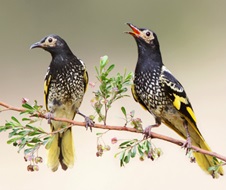The successful hatching of a trio of chicks is great news for a program releasing zoo-bred regent honeyeaters to integrate and breed with wild populations of the rare songbird.

The chicks are the first confirmed zoo-wild offspring from the NSW regent honeyeater recovery program, which released 14 zoo-bred birds in November during the spring breeding season in the Greater Blue Mountains region.
The hatching comes 2 years after the mother, a zoo-bred bird tagged ‘RMPP’, was released into the Tomalpin Woodlands in the Lower Hunter Valley.
Since that time, RMPP has flown more than 134 km west to Capertee National Park, where she and a wild male saw 2 of their chicks fledge last spring. The fledglings were last sighted at the end of November and it is hoped they have joined the wild flock of birds. RMBO, another zoo-bred female released along with RMPP in October 2021, was spotted in November with a wild-born partner at a second NSW breeding site in the Upper Hunter.
RMBO hatched and raised a chick with a zoo-bred male in the Tomalpin Woodlands after their release in 2021 – the first zoo-bred regent honeyeaters to successfully breed in the wild in New South Wales.
A third zoo-bred female, ORKM, also paired with a wild male at another location in the Capertee Valley. She was seen twice before moving on, away from the monitoring team’s survey sites.
This year’s spring breeding event of the critically endangered regent honeyeater is the largest in Capertee National Park and surrounds since 2017, with more than a dozen nests and at least 16 fledglings accounted for.
With as few as 250 to 300 regent honeyeaters estimated to remain in the wild, every successful breeding event is critical.
The regent honeyeater breeding program is a conservation partnership between the NSW’s Government’s Saving our Species program, Taronga Conservation Society Australia and BirdLife Australia.
The program has seen the release of 140 zoo-bred birds in New South Wales.







